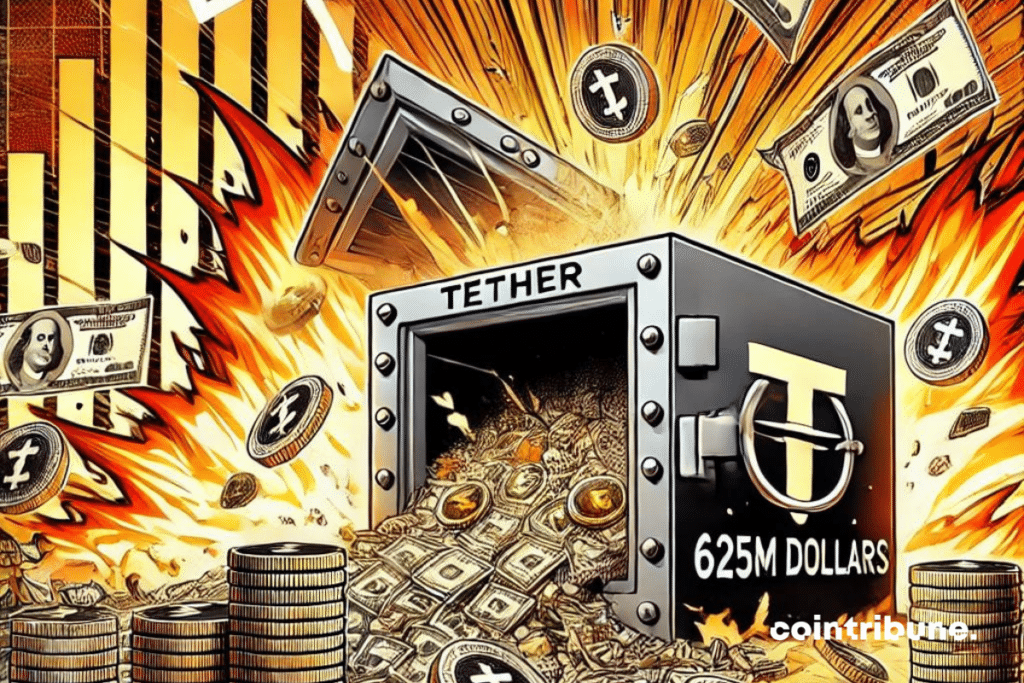19:00 ▪
5
min reading ▪ acc
As the Federal Reserve (Fed) begins to change the course of interest rates, Tether and four other stablecoin issuers risk losing $625 million in annual interest income. This upheaval, revealed by a recent CCData report, highlights stablecoins’ reliance on US Treasuries, a fundamental pillar of their economic model.

The Fed changes course: an earthquake for stablecoins
Since the rise of stablecoins, these real-asset-backed cryptocurrencies have positioned themselves as pillars of stability in the ecosystem.
But their success is largely based on a strategy of investing in US Treasuries, assets known for their safety and yield. However, the Fed’s recent decision to cut interest rates has reshuffled the cards.
This is because when interest rates fall, so do government bond yields. For issuers like Tether, whose reserves are nearly 80% of government bonds, this means an immediate reduction in the income generated by these investments.
According to CCData, this decline could cost the stablecoin industry around $625 million, a staggering figure that reflects their degree of dependence on US monetary policy.
The numbers speak for themselves: Tether, the undisputed stablecoin leader with $93.2 billion in assets under management, is particularly exposed.
Its record earnings of $5.2 billion in the first half of 2024 are based largely on yields on its US government bonds. Now these revenues are in serious jeopardy.
Diversification: the future of stablecoins?
In the face of this threat, the question arises: can stablecoins continue to thrive with only T-bills? Some indications are that issuers of stablecoins such as Tether have already started diversification strategies to compensate for this vulnerability.
Tether recently invested more than $112 million in agribusiness in Argentina, a move that is surprising for the crypto company but illustrates a desire to diversify its income.
This agribusiness investment reflects a growing trend among stablecoin issuers to explore sectors outside of finance to secure new sources of revenue. The question remains: will this diversification be enough to offset the loss of treasury revenues?
Other cryptocurrencies, such as Circle’s USDC, are in a similar position. With $28.7 billion in Treasuries, USDC is in a comparable position to Tether. But Circle is banking on more dynamic fund management, particularly through its Circle Reserve Fund, to cushion the impact of falling rates.
Towards a change in the economic model?
The Fed’s decision deserves special attention. This change could mark a turning point in the stablecoin economy.
Interest income from Treasury bills has long been the main source of profits for these companies, allowing them to operate while ensuring the stability of their tokens. If those yields fall, it could force issuers to rethink their business model.
One option for stablecoin issuers would be to raise service fees or explore new investment avenues.
But this brings challenges: how to maintain user trust while adapting their model to a lower interest rate environment? If Tether, Circle and other stablecoins do not find viable alternatives, they risk losing competitiveness to other players in decentralized finance, less dependent on traditional assets.
The pressure is mounting and eyes are now on the future strategies of stablecoin issuers. Will they weather this storm or will they have to give way to more agile alternatives? The stablecoin sector faces a big challenge with this Fed decision. While losses of $625 million may seem bearable in the short term for giants like Tether, the question of their long-term resilience remains open. The economic model that made them successful now seems to be in the hot seat. Meanwhile, Bitcoin and altcoins are plummeting.
Maximize your Cointribune experience with our “Read and Earn” program! Earn points for every article you read and get access to exclusive rewards. Register now and start reaping the benefits.

Fascinated by Bitcoin since 2017, Evariste continued to research the topic. If his first interest was trading, now he is actively trying to understand all the developments focused on cryptocurrencies. As an editor, he strives to consistently deliver high-quality work that reflects the state of the industry as a whole.
DISCLAIMER OF LIABILITY
The comments and opinions expressed in this article are solely those of the author and should not be considered investment advice. Before making any investment decision, do your own research.

